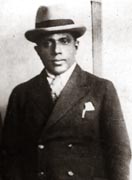
A.E. Goonesinha
by Kesera Ekanayake Goonesinha - Daily News Wed May 1, 2002
|
|
Alexander Ekanayake Goonesinha, Pioneer trade union Leader, was born at Kandy on May Day (1st May, 1891) and was educated at Dharmaraja College, Kandy, and later at St. Joseph's College, Colombo.
He was first in the field of organising trade unions, and in 1922 formed the Ceylon Labour Union, in 1928 the All Ceylon Labour Union Congress, and later in 1935 the Ceylon Trade Union Congress was formed by the amalgamation of several Unions including the Ceylon Mercantile of which he was the President for 20 years.
Mr. Goonesinha led a series of successful strikes, and the first General Strike occurred in February, 1923, when the Government Railway struck and was joined by a number of other Unions. In all about 25,000 workers were supplied with free meals for 56 days. The Strike was a great success, and a Commission appointed by the British Governor Manning recommended a 20% increase in Salaries and Casual & Sick leave facilities. Subsequently, Mr. Goonesinha led a series of Strikes to Victory, and the most militant Strike was the Tram Car strike in January, 1929. The Harbour workers too struck in sympathy.
In retaliation, European Planters and Executives drove Tram Cars and this sparked off trouble. The Late President J.R. Jayewardene, who was a student, joined the many other helpers to transport the crowds of people who boycotted travelling in Tarm Cars. On the 5th February 1929, a clash took place between the Police and the Strikers, and the Maradana Police Station was set on fire.
It was a Colonial period and Ceylon was ruled by the British Empire, and Mr. Goonesinha was brave and courageous to meet any eventuality to fight for the rights of the workers, and due to his daringness, the Workers called him the Maha Kalu Sinhaya. Mr. Goonesingha's political career marked the formation of the Ceylon Labour Party in October, 1928, with himself as President, and Proctor Marshall Perera as Secretary, and Messrs. C.E. Corea, C.H. Fernando, C.W.W. Kannangara, George E. de Silva in the Committee not forgetting, of course, the Late President, Ranasinghe Premadasa, later, who was a very eloquent speaker.
In 1940, Mr. Goonesinha was elected to the Colombo Municipal Council and was the first Sinhalese Mayor. He was elected to the Colombo Central Seat of the first State Council in 1931 and again in 1936. In 1947, he was elected as the first Member for the Colombo Central Seat (three Member seat) in Parliament and was appointed the Chief Government Whip and Minister of State. Mr. Goonesinha was also Ceylon's Ambassador to Burma and Indonesia.
Mr. Goonesinha's note-worthyness again as a National Hero goes back to July, 1928, when he represented Ceylon at the British Empire Labour Conference, London, and was responsible in obtaining for Ceylon the Universal Adult Suffrage from the Donoughmore Commission. He was also responsible for the abolition of the Poll Tax in 1925, and as a mark of Honour his statue has been erected at the entrance to Goonesinghapura depicting him with a hammer in hand breaking rock stones for Civil Disobedience in not paying Poll Tax. This statue is garlanded every May Day.
It must be mentioned here that Mr. Goonesinha's worthy disciple, the Late President R. Premadasa, as a mark of Honour, had converted Price Park and the environment in Pettah, as Goonesinhapura. Price Park is the place where Mr. Goonesinha and his disciple had their trade union and Political meetings, and where large crowds gathered to listen to the heart-throbbing and elequent Speeches of the Guru and his disciple. This Park is now re-named Goonesinha Park, a land-mark of yester-year.
A.E. Goonesinha, the National Hero, silently passed away on the 1st of August, 1967, and was carried through the streets of Colombo by the people, the workers, to his last resting place at Kanatte.